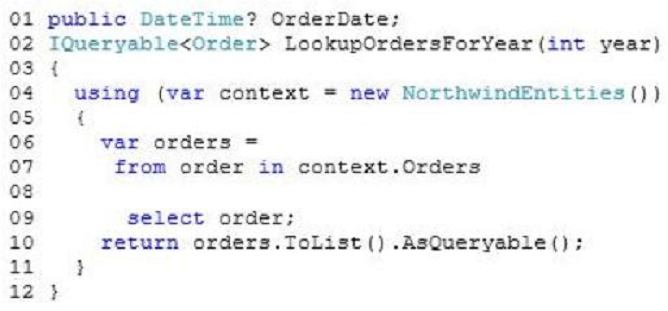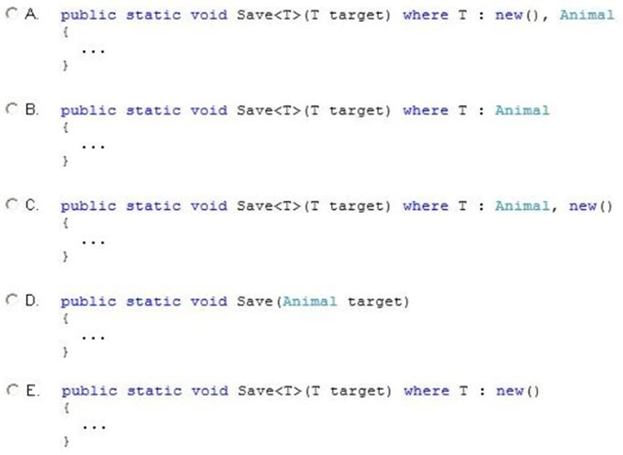Download Programming in C#.70-483.BrainDumps.2019-10-24.168q.vcex
| Vendor: | Microsoft |
| Exam Code: | 70-483 |
| Exam Name: | Programming in C# |
| Date: | Oct 24, 2019 |
| File Size: | 19 MB |
How to open VCEX files?
Files with VCEX extension can be opened by ProfExam Simulator.
Discount: 20%
Demo Questions
Question 1
You are developing an application that includes a class named Order. The application will store a collection of Order objects.
The collection must meet the following requirements:
- Use strongly typed members.
- Process Order objects in first-in-first-out order.
- Store values for each Order object.
- Use zero-based indices.
You need to use a collection type that meets the requirements.
Which collection type should you use?
- Queue<T>
- SortedList
- LinkedList<T>
- HashTable
- Array<T>
Correct answer: A
Explanation:
Queues are useful for storing messages in the order they were received for sequential processing. Objects stored in a Queue<T> are inserted at one end and removed from the other. References: http://msdn.microsoft.com/en-us/library/7977ey2c.aspx Queues are useful for storing messages in the order they were received for sequential processing. Objects stored in a Queue<T> are inserted at one end and removed from the other.
References: http://msdn.microsoft.com/en-us/library/7977ey2c.aspx
Question 2
You are developing an application. The application calls a method that returns an array of integers named employeeIds. You define an integer variable named employeeIdToRemove and assign a value to it. You declare an array named filteredEmployeeIds.
You have the following requirements:
- Remove duplicate integers from the employeeIds array.
- Sort the array in order from the highest value to the lowest value.
- Remove the integer value stored in the employeeIdToRemove variable from the employeeIds array.
You need to create a LINQ query to meet the requirements.
Which code segment should you use?

- Option A
- Option B
- Option C
- Option D
Correct answer: C
Question 3
You are developing an application that includes the following code segment. (Line numbers are included for reference only.)

The GetAnimals() method must meet the following requirements:
- Connect to a Microsoft SQL Server database.
- Create Animal objects and populate them with data from the database.
- Return a sequence of populated Animal objects.
You need to meet the requirements.
Which two actions should you perform? Each correct answer presents part of the solution.
NOTE: Each correct selection is worth one point.
- Insert the following code segment at line 16:while(sqlDataReader.NextResult())
- Insert the following code segment at line 13:sqlConnection.Open();
- Insert the following code segment at line 13:sqlConnection.BeginTransaction();
- Insert the following code segment at line 16:while(sqlDataReader.Read())
- Insert the following code segment at line 16:while(sqlDataReader.GetValues())
Correct answer: BD
Explanation:
SqlConnection.Open - Opens a database connection with the property settings specified by the ConnectionString. SqlDataReader.Read - Advances the SqlDataReader to the next record. References:http://msdn.microsoft.com/en-us/library/system.data.sqlclient.sqlconnection.open.aspxhttp://msdn.microsoft.com/en-us/library/system.data.sqlclient.sqldatareader.read.aspx - SqlConnection.Open - Opens a database connection with the property settings specified by the ConnectionString.
- SqlDataReader.Read - Advances the SqlDataReader to the next record.
References:
http://msdn.microsoft.com/en-us/library/system.data.sqlclient.sqlconnection.open.aspx
http://msdn.microsoft.com/en-us/library/system.data.sqlclient.sqldatareader.read.aspx
Question 4
You are developing an application that uses the Microsoft ADO.NET Entity Framework to retrieve order information from a Microsoft SQL Server database. The application includes the following code. (Line numbers are included for reference only.)

The application must meet the following requirements:
- Return only orders that have an OrderDate value other than null.
- Return only orders that were placed in the year specified in the OrderDate property or in a later year.
You need to ensure that the application meets the requirements.
Which code segment should you insert at line 08?
- Where order.OrderDate.Value != null && order.OrderDate.Value.Year >= year
- Where order.OrderDate.Value == null && order.OrderDate.Value.Year == year
- Where order.OrderDate.HasValue && order.OrderDate.Value.Year == year
- Where order.OrderDate.Value.Year == year
Correct answer: A
Explanation:
For the requirement to use an OrderDate value other than null use: OrderDate.Value != null For the requirement to use an OrderDate value for this year or a later year use: OrderDate.Value>= year - For the requirement to use an OrderDate value other than null use: OrderDate.Value != null
- For the requirement to use an OrderDate value for this year or a later year use: OrderDate.Value>= year
Question 5
An application receives JSON data in the following format:

The application includes the following code segment. (Line numbers are included for reference only.)

You need to ensure that the ConvertToName() method returns the JSON input string as a Name object.
Which code segment should you insert at line 10?
- Return ser.ConvertToType<Name>(json);
- Return ser.DeserializeObject(json);
- Return ser.Deserialize<Name>(json);
- Return (Name)ser.Serialize(json);
Correct answer: C
Explanation:
JavaScriptSerializer.Deserialize<T> - Converts the specified JSON string to an object of type T. References: http://msdn.microsoft.com/en-us/library/bb355316.aspx JavaScriptSerializer.Deserialize<T> - Converts the specified JSON string to an object of type T.
References: http://msdn.microsoft.com/en-us/library/bb355316.aspx
Question 6
You are developing an application. The application converts a Location object to a string by using a method named WriteObject. The WriteObject() method accepts two parameters, a Location object and an XmlObjectSerializer object.
The application includes the following code. (Line numbers are included for reference only.)

You need to serialize the Location object as a JSON object.
Which code segment should you insert at line 20?
- New DataContractSerializer(typeof(Location))
- New XmlSerializer(typeof(Location))
- New NetDataContractSerializer()
- New DataContractJsonSerializer(typeof(Location))
Correct answer: D
Explanation:
The DataContractJsonSerializer class serializes objects to the JavaScript Object Notation (JSON) and deserializes JSON data to objects. Use the DataContractJsonSerializer class to serialize instances of a type into a JSON document and to deserialize a JSON document into an instance of a type. The DataContractJsonSerializer class serializes objects to the JavaScript Object Notation (JSON) and deserializes JSON data to objects.
Use the DataContractJsonSerializer class to serialize instances of a type into a JSON document and to deserialize a JSON document into an instance of a type.
Question 7
You are developing an application by using C#. The application includes the following code segment. (Line numbers are included for reference only.)

The DoWork() method must not throw any exceptions when converting the obj object to the IDataContainer interface or when accessing the Data property.
You need to meet the requirements. Which code segment should you insert at line 07?
- var dataContainer = (IDataContainer)obj;
- dynamic dataContainer = obj;
- var dataContainer = obj is IDataContainer;
- var dataContainer = obj as IDataContainer;
Correct answer: D
Explanation:
As - The as operator is like a cast operation. However, if the conversion isn't possible, as returns null instead of raising an exception. Reference:http://msdn.microsoft.com/en-us/library/cscsdfbt(v=vs.110).aspx As - The as operator is like a cast operation. However, if the conversion isn't possible, as returns null instead of raising an exception.
Reference:
http://msdn.microsoft.com/en-us/library/cscsdfbt(v=vs.110).aspx
Question 8
You are creating an application that manages information about zoo animals. The application includes a class named Animal and a method named Save.
The Save() method must be strongly typed. It must allow only types inherited from the Animal class that uses a constructor that accepts no parameters.
You need to implement the Save() method.
Which code segment should you use?

- Option A
- Option B
- Option C
- Option D
- Option E
Correct answer: C
Explanation:
When you define a generic class, you can apply restrictions to the kinds of types that client code can use for type arguments when it instantiates your class. If client code tries to instantiate your class by using a type that is not allowed by a constraint, the result is a compile-time error. These restrictions are called constraints. Constraints are specified by using the where contextual keyword. References:http://msdn.microsoft.com/en-us/library/d5x73970.aspx When you define a generic class, you can apply restrictions to the kinds of types that client code can use for type arguments when it instantiates your class. If client code tries to instantiate your class by using a type that is not allowed by a constraint, the result is a compile-time error. These restrictions are called constraints. Constraints are specified by using the where contextual keyword.
References:
http://msdn.microsoft.com/en-us/library/d5x73970.aspx
Question 9
You are developing an application that will convert data into multiple output formats.
The application includes the following code. (Line numbers are included for reference only.)

You are developing a code segment that will produce tab-delimited output. All output routines implement the following interface:

You need to minimize the completion time of the GetOutput() method.
Which code segment should you insert at line 06?

- Option A
- Option B
- Option C
- Option D
Correct answer: B
Explanation:
A String object concatenation operation always creates a new object from the existing string and the new data. A StringBuilder object maintains a buffer to accommodate the concatenation of new data. New data is appended to the buffer if room is available; otherwise, a new, larger buffer is allocated, data from the original buffer is copied to the new buffer, and the new data is then appended to the new buffer. The performance of a concatenation operation for a String or StringBuilder object depends on the frequency of memory allocations. A String concatenation operation always allocates memory, whereas a StringBuilder concatenation operation allocates memory only if the StringBuilder object buffer is too small to accommodate the new data. Use the String class if you are concatenating a fixed number of String objects. In that case, the compiler may even combine individual concatenation operations into a single operation. Use a StringBuilder object if you are concatenating an arbitrary number of strings; for example, if you're using a loop to concatenate a random number of strings of user input. References: http://msdn.microsoft.com/en-us/library/system.text.stringbuilder(v=vs.110).aspx A String object concatenation operation always creates a new object from the existing string and the new data.
A StringBuilder object maintains a buffer to accommodate the concatenation of new data. New data is appended to the buffer if room is available; otherwise, a new, larger buffer is allocated, data from the original buffer is copied to the new buffer, and the new data is then appended to the new buffer.
The performance of a concatenation operation for a String or StringBuilder object depends on the frequency of memory allocations. A String concatenation operation always allocates memory, whereas a StringBuilder concatenation operation allocates memory only if the StringBuilder object buffer is too small to accommodate the new data. Use the String class if you are concatenating a fixed number of String objects. In that case, the compiler may even combine individual concatenation operations into a single operation. Use a StringBuilder object if you are concatenating an arbitrary number of strings; for example, if you're using a loop to concatenate a random number of strings of user input.
References: http://msdn.microsoft.com/en-us/library/system.text.stringbuilder(v=vs.110).aspx
Question 10
You are developing an application by using C#.
The application includes an object that performs a long running process.
You need to ensure that the garbage collector does not release the object's resources until the process completes.
Which garbage collector method should you use?
- ReRegisterForFinalize()
- SuppressFinalize()
- Collect()
- WaitForFullGCApproach()
Correct answer: B
HOW TO OPEN VCE FILES
Use VCE Exam Simulator to open VCE files

HOW TO OPEN VCEX AND EXAM FILES
Use ProfExam Simulator to open VCEX and EXAM files


ProfExam at a 20% markdown
You have the opportunity to purchase ProfExam at a 20% reduced price
Get Now!



